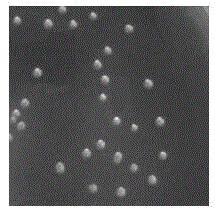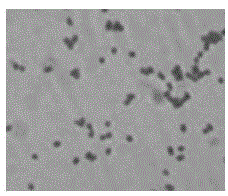A serratia marcescens strain producing high-purity 2-keto-D-gluconic acid
A technology of Serratia marcescens and gluconic acid, applied in the field of microorganisms, can solve the problems of low conversion rate, bacteriophage contamination, low purity and the like
- Summary
- Abstract
- Description
- Claims
- Application Information
AI Technical Summary
Problems solved by technology
Method used
Image
Examples
Embodiment 1
[0071] Example 1 Acquisition of Serratia marcescens CGMCC No.10548 bacteria
[0072] Serratia marcescens (Serratia marcescens) SDSPY-136 strain producing high-purity 2-keto-D-gluconic acid has been preserved in the General Microbiology Center of China Committee for the Collection of Microbial Cultures, and its preservation number is CGMCC No. : 10548, and its preservation time is: February 9, 2015.
[0073] The collection strain of the present invention, that is, the Serratia marcescens SDSPY-136 strain producing high-purity 2-keto-D-gluconic acid, the acquisition steps are as follows:
[0074]1) The microorganisms in the garden soil sample were inoculated in the enrichment medium. After enrichment culture, they were serially diluted, and then spread on bromocresol purple-calcium carbonate screening plates, and cultured at 30°C for 1-2 days; The single colony with a large circle was transferred to the slant medium for 1-2 days at 30°C, and then the shake flask fermentation wa...
Embodiment 2
[0088] Example 2 Biological characteristics, physiological and biochemical characteristics and 16S rRNA gene sequencing of Serratia marcescens CGMCC No. 10548 strain
[0089] A The biological characteristics of this preserved strain are: observed after cultured on a solid culture plate (separation medium) at 30°C for 24 hours, the colony can form a red round colony with a smooth and moist surface, slightly raised (such as figure 1 , figure 2 shown), under the optical microscope, the bacteria were nearly spherical and short rod-shaped, Gram staining was negative, and there were no spores (such as image 3 shown). The composition of the solid medium for bacterial morphology observation (g / L): peptone 5, sodium chloride 5, beef extract 3, agar 18, pH 7.0. For the experimental method of observing the above morphological characteristics, refer to "Handbook of Common Bacterial System Identification" edited by Dong Xiuzhu, Cai Miaoying, etc., Science Press, 2001, first edition...
Embodiment 3
[0133] Example 3 Application of Serratia marcescens CGMCC No.10548 strain
[0134] Medium:
[0135] The composition of the slant medium is (g / L): peptone 5, sodium chloride 5, beef extract 3, agar 20, pH 7.0;
[0136] The composition of the liquid seed medium is (g / L): peptone 5, sodium chloride 5, beef extract 3, pH 7.0;
[0137] The composition of the fermentation medium is (g / L): glucose 110, corn steep liquor 10, KH 2 PO 4 1. MgSO 4 ·7H 2 O 0.8, FeSO 4 ·7H 2 O 0.036, CaCO 3 50, pH7.0.
[0138] Method for producing 2-keto-D-gluconic acid using the collection strain
[0139] 1) Serratia marcescens (Serratia marcescens) CGMCC N0.10548 strain was transferred to the slant medium for activation;
[0140] Prepare the seed medium according to the composition of the above-mentioned liquid seed medium. The liquid volume in a 250ml triangular bottle is 30ml, steam sterilize at 121°C for 20 minutes, cool to room temperature, inoculate 2 rings of slant strains, set the ...
PUM
 Login to View More
Login to View More Abstract
Description
Claims
Application Information
 Login to View More
Login to View More - R&D
- Intellectual Property
- Life Sciences
- Materials
- Tech Scout
- Unparalleled Data Quality
- Higher Quality Content
- 60% Fewer Hallucinations
Browse by: Latest US Patents, China's latest patents, Technical Efficacy Thesaurus, Application Domain, Technology Topic, Popular Technical Reports.
© 2025 PatSnap. All rights reserved.Legal|Privacy policy|Modern Slavery Act Transparency Statement|Sitemap|About US| Contact US: help@patsnap.com



